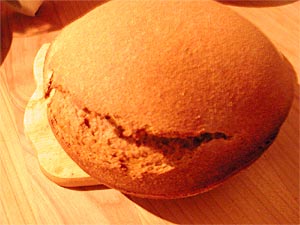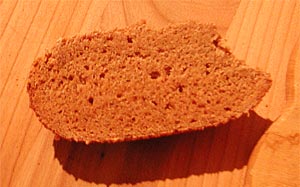Desem, Day 8-9: The First Loaf
This is the continuation of my accounts of making desem bread, which is made with just flour, water, salt and nothing else. It's somewhere between regular baking and a science project.
I am writing this somewhat bleary-eyed after a late night...
The process of making the first loaf of desem bread is very long, and it's easy to miscalculate the time needed. That's what I did. Here's how it went...
Saturday, 12 noon: I take out the desem which has been ripened at room temperature (around 21° C or 70° F) overnight. (This is where I went wrong..I should have started earlier.) I add 1 1/2 cups of bottled water, soften the desem (this seems to be getting easier - the desem already is losing that gluten-rubbery feeling. The micro-organisms seem to prefer eating the gluten, so a mature ripened desem has almost no gluten left.), mix in 1 1/2 tablespoons of salt and add 3 cups of whole wheat flour. Then comes the hard part. The dough needs kneeding (no pun intended) for 600 strokes or 20 minutes by hand.
There are two ways of dealing with the kneading problem. One is to cave in and buy a KitchenAid. The other is to consider it as a kind of therapeutic exercise. That's the approach I have taken so far (I do some white bread doughs and pizza dough in the food processor). The kneading time for desem is indeed very long, but it's sort of like taking a bath or being stuck on the train with no reading material - your mind is free to wander.
After 10 minutes of contemplative kneading, I go and get my iPod.
Finally kneaded well and feeling quite stretchy, I round it off into a bowl, then put it in a covered bowl for the first rising. The first rising for the first loaf takes eight to ten hours. Yes, that is a long time. The temperature for this stage is again cool room temperature.
Saturday, 21:30/9:30PM: The dough has risen a bit, maybe to about 1 1/2 times its original volume. That's to be expected for the first loaf. The desem hasn't developed its full leavening powers yet. I give the dough a good punch.
Saturday, 22:30/10:30PM: It's now time for it's final warm rising. I take out the dough, punch it down, and round it off once, then twice, forming a tight gluten coat on the outside. This is supposed to help it rise nice and high. I butter the lid of a glass casserole dish, sprinkle with corn meal, and place the rounded dough on it. I then put the bowl of the casserole on top like a dome, put the whole thing in a plastic bag I've wetted on the inside, close up the plastic bag and put it in the oven that's just turned on to the lowest possible setting.
Let me explain. For the final rising, the dough has to be in a high humidity, warm location. For me that means the electric oven turned on to below the "keep warm" stage, and the plastic bag. I've been thinking for a while of building a kind of dough incubator - have a heating pad or electric blanket in a styrofoam box, with some source of humidity (the plastic bag would still work in this)...but I haven't gotten around to building it yet. Anyway, the oven does get a tad too warm (around 50°C) but I try to compensate by turning it off, then on, a couple of times throughout the rising period. The rising period is 1 1/2 to 2 hours.
Yes, I had to wait for the dough to finish rising at around 1:30 AM. Miscalculation indeed. It wasn't so bad though since it's the weekend and I'm a night owl anyway. For the last 30 minutes I take the dough out of the oven to heat it up to 230°C (around 450° F), and keep the covered bowl on a pullout shelf in front of the oven where it's plenty warm.
Sunday, 1:30 AM: Time to bake finally! For some added humidity I spray the inside of the bowl with water, and put the whole thing in the oven. It bakes for about 20 minutes at the high temperature, and then about 50 minutes at 180° C/350° F, until the loaf is done. When is it done? When if you rap on the bottom, there's a hollow sound.
Sunday, 3:00 AM - ish: I'm very sleepy now, but the house is smelling pretty good. I take the loaf out of the oven. Oops, the top has split:

I realize I forgot to do one thing, which was to poke some holes in the top of the dough before baking. Well it's not too bad. I can't resist taking a slice to take a look at the inside:

It's a pretty dense crumb, but it has definitely risen. The crust is marvelously crispy if a bit thick, and the flavor is good. I leave it to cool on a rack and go to sleep finally.
Sunday, noon Someone's been nibbling on the bread already. I take another thin slice, it's definitely good. Next week I'll bake the second loaf, and compare it to this first one. It should be lighter for sure.
Which brings us to the Care and Feeding of Desem, which is in the next post.
How to eat the first loaf: This first loaf is pretty dense, like a German pumpernickel, so it's best eaten like that kind of bread is, thinly sliced. We had some for lunch with a bit of butter and ham, cheese (a walnut cheese and some cream cheese), and smoked mackerel, and it was really good.
And, in case you're wondering if every loaf is going to take 14-15 hours to complete, don't worry. It's only for the first "immature" loaves. The loaf next week may take just as long to rise. If it has already achieved maturity it will only take 4 hours. I'll wait and see.
If you enjoyed this article, please consider becoming my patron via Patreon. ^_^

 Welcome to Just Hungry, where we serve authentic Japanese recipes and more! I'm
Welcome to Just Hungry, where we serve authentic Japanese recipes and more! I'm 















Comments
Shantel Jones
1 February, 2008 - 20:30
Permalink
Thanks! I was wondering what
Thanks! I was wondering what you did about the humidity!
anon
15 March, 2009 - 20:16
Permalink
Re: Desem, Day 8-9: The First Loaf
I am just starting out with my first desem, I used Laurel's as my guide and the instructions are rather more convoluted than they need be, so it's great to have this to refer to. My first loaf was a complete flop & I fed it to our dog. I now see from your notes what the problem was, I added more flour than was in the starter .... however, it survived & I tried it again on the second week & it worked.. my first taste of real european bread since I was in Germany!. Thanks so much for your blog, it's great to have your pictures as a reference!
jo
Loretta
31 October, 2011 - 14:04
Permalink
Re: Desem, Day 8-9: The First Loaf
Oh, wow!
I started kneading yesterday evening having given the desem a full day at a 21C room temperature whilst I was out of the house. This meant it could prove overnight at a slightly cooler temperature - all ready to punch down in the morning. The perfect start to a day!
It's 1pm and I've just allowed the bread to cool as much as I could before I gave in and cut off a slice of still warm bread.
Sure, my loaf was a bit of a brick. Looks extremely similar to yours (I did poke holes in, but obviously not enough nor deep enough - I don't really understand about how to score bread), it even broke the same way. But it wasn't actually solid, there were enough air holes to make it have a pleasurable texture. But it's the taste that's absolutely overwhelmed me. The only way I can describe it is that the process has given the wheat all the complexity of flavour of great chocolate.
And this will get better?!?
I'm very happy to have reached this far on your desem journey. Love the view so far, looking forward to reaching the real highlights of this trip.
Thank you!